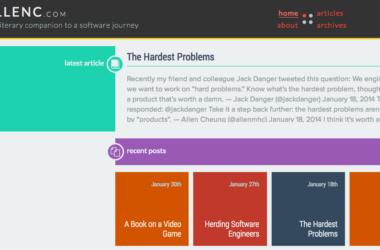Recently, I’ve attended a couple of in-person industry conferences—more than years past, finally peeking out from the shadow of COVID—and met some peers who complimented me on this blog. I’m of course flattered; despite doing this for 12+ years, I do not do a great job of promoting or SEOing my little corner of the internet. The main thing I have going here is posting consistently, every week, iterating on both my literary voice as well as the process of capturing stray thoughts into notes and turning that into something readable1. The hardest part is to establish the habit, and to maintain motivation when writing to an underdeveloped audience2.
As I was working through the mundane method of consistent informal writing, I realized that it sounds a whole lot like the advice given to content creators of all stripes. Having never connected what I’ve been doing to creating content—I started this before people wanted to become YouTubers—it seems obvious in retrospect. Blogging, even on niche technical and technological and management topics, is still commoditized stuff on the internet and subject to the dynamics of our broader information ecosystem.
Yes, there’s the AI angle, which ingests and emulates content. That’s a well-trodden, straight up trampled path at this point. Instead, I want to highlight the corrosive nature of treating everything as content, and the incentives shaping its consumption and thus its creation. This article outlines such a perspective:
The internet and modern technology have lowered barriers of entry for anybody looking to make content, and that’s what everyone started to do. At the same time, there are only a finite number of hours in a day, and attention spans are zero-sum. This combination produces power law distributions: the most popular content producers reap the vast majority of the value accrued—in views, then fame, then dollars—and everyone who isn’t at the top is looking to fight their way there. It forms the basis of what seems to be the modus operandi for producing content in the modern internet age: make something, engage your audience, repeat but gradually amp it up, and build an audience along the way. One quick and easy way to engage consistently is to produce real-time, controversial opinions in reaction to events3.
This is our culture of hot takes. Or, further simplified given its current prevalence, simply, takes.
Focusing on immediate reactions incurs a tradeoff. Takes are by definition quick and shallow, so nuanced discourse—which requires more work to both create and consume—struggles to gain momentum and traction. It doesn’t help that content aggregators, Facebook and YouTube and Google search rankings and Spotify, refine their recommendation algorithms to promote exactly this kind of behavior, in service of user engagement that ultimately translates eyeballs to advertising dollars4.
It’s instructive to look at how sports talk, which originated this type of content generation with sports radio and podcasts, has refined the art. Hot takes are critical to how the industry works, and their effectiveness is proven in the saturation of airwaves as well as their viewerships. A recent Stratechery interview with a sports radio programming manager5 also honed in on the truth: the point of takes is not to resolve debates, but to generate them and hold users’ attention.
Unfortunately, this blog’s tagline is creating space for reflection, which probably dooms me to another decade of mild, considered takes.
Tactically, I keep a folder of ½-baked thoughts, along with my set of Zettelkasten notes. In moments of flow state, I crank out a bunch of drafts at once.↩
Of course, I still appreciate all of you reading!↩
Negative emotions trump positive ones; such is the way we’re wired.↩
The Age of Attention did predict this development, ½ a decade ago.↩
To be clear, this is scheduling for radio shows, not acts of software development.↩


